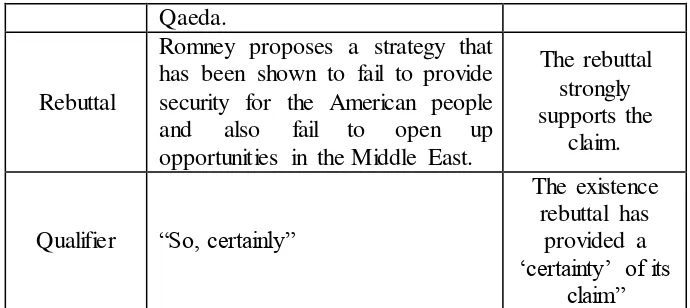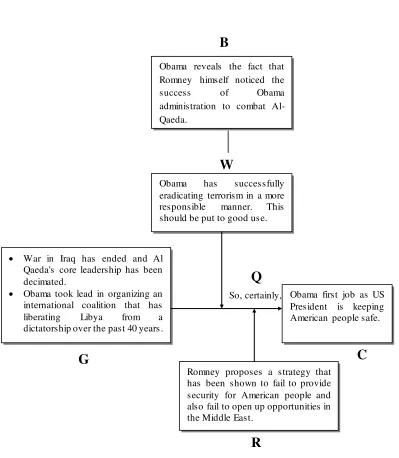CHAPTER III RESEARCH METHOD
3.1 Introduction
This chapter aims to give a description concerning the procedure of this study. The first section covers the formulation of problems which comprises the issues being analyzed in this study. Later, the research design applied during the course of this study encompasses a conceptual structure used in the research. It constitutes the design of the collection of data and the analysis of the data collected.
3.2 Formulation of the Problems
This study presents an examination of argumentation that is used in a presidential debate. It covers an investigation of the strength of presidential
candidate‟s argument in convincing the public that he deserves to be the nation‟s leader. Here, the strength of an argument is determined by a 'logical relationship' between each element that constitute an argument. The constituent elements of an argument, namely: claim, grounds, warrant, backing, rebuttal and qualifier that are used in this study is based on Toulmin Argumentation Model(1958)
3.3 Research Design
The study employed the theory of measuring arguments‟ strength proposed by Toulmin (1984). The framework is well known as „Toulmin‟s Argumentation Model' which contains two levels of analysis, namely: soundness analysis and strength level analysis. In this study, the researcher added the term
„cogency‟ from Birkett (2005) as the initial level to further simplify the study in determining the feasibility of argument.
Thus, there were three stages of analysis in conducting this research. The stages include: cogency analysis, soundness analysis and strength level analysis. At the cogency analysis, an argument was analyzed according to the factuality of its grounds and the validity of its warrant. Then, the researcher looked for the presence of backing element that was required to determine an argument‟s soundness. The last, the strength of an argument was measured and determined based on its appropriate qualification (qualifier).
3.4 Data Collection
The data of the present study was a debate transcription of the latest American presidential debates in 2012. The data was taken from a relevant internet source, www.debates.org. This website is shaded by a nonprofit, nonpartisan organization, namely the Commission on Presidential Debates (CPD). CPD was established in 1987 and chaired by Frank J. Fahrenkopf, Jr. and Michael D. McCurry. The primary purpose of CPD is to sponsor and produce debates for the United States presidential and vice presidential candidates. The website is also provided for research and educational activities relating to the presidential debates.
From the main transcription, the researcher selected 40 arguments which contain at least the three primary elements, such as claim, ground and warrant. The importance of the presence of these three basic elements in constructing a
“Claim (C) as the main purpose of an argument that tells what exactly an argument is about, where the argument stands for and a certain position that must
be considered by the audience so that they will agree with the outcome of the
argument. The grounds (G) are the underlying foundation that must be solid and
reliable or based on facts. Last, the warrant (W) is an assumption which links the
claim to its grounds. Here, an argument is said to be cogent if it has factual
grounds and a valid warrant.” (Toulmin, 1984: 25)
The selected arguments consist of 20 arguments from Obama and 20 arguments from Romney. Later, the selected arguments were analyzed in the data analysis section.
3.5 Data Analysis
The data analysis was divided into several steps. The first step was related to the observation of Toulmin's argumentation elements in the debate. Each transcription that has been collected was examined and marked according to the type of element contained therein.
The second step was restating the data that have been marked into an indirect form which involved the assignment of reporting and paraphrasing. This step was intended to shorten a very long statement so that the data easier to understand and facilitate further analysis.
Later, in the third step of analysis, the researcher implemented the three stages of analysis to the research data.
3.5.1 Cogency Analysis, Soundness Analysis and Strength Level Analysis
The study contains three stages of analysis, such as: cogency analysis,
By examining the cogency of an argument, the researcher was not only able to determine the quality of the three basic constituent elements, but also able to see the connection between these essential elements.
In the second stage of analysis, backing (B) is required as an additional relationship to Grounds, Warrant and Backing (Toulmin, 1984).
3.5.2 Examples of Data Analysis
3.5.2.1 Stage 1: Cogency Analysis
The first stage of the data analysis of this research was the analysis of cogency. The analysis is presented as follows:
Table 3.1 The Primary Elements of Transcription No.2
Primary
Table 3.1 above displays the primary elements of the transcription No.2 presents the additional elements of the transcription No.2 including backing element.
Table 3.2 The Additional Elements of Transcription No. 2 Additional coalition that has liberating
Libya from a dictatorship over the past 40 years.
- Ten thousand Libyan in Benghazi marching after the
events and saying: “America is our friend”.
Warrant
Qaeda.
Rebuttal
Romney proposes a strategy that has been shown to fail to provide security for the American people and also fail to open up opportunities in the Middle East.
The rebuttal strongly supports the
claim.
Qualifier “So, certainly”
The existence rebuttal has
provided a
„certainty‟ of its claim”
Table 3.2 presents additional elements of the transcription No.2. The first column indicates the additional elements which occur in the argument. The second column indicates the description or arguments which have been marked as the additional elements. The third column presents the analysis results of each additional element. Based on the analysis result on table 3.2 the argument is
„sound‟ because the backing supports the validity of the warrant.
3.5.2.3 Stage 3: Strength Level Analysis
As indicated in table 3.2, the argument has a strong qualifier (“so, certainly”) because it includes the grounds that are reasonably needed (based on fact), the warrant is clearly relevant and the solidity of its backing is unchallenged (valid reasoning). Furthermore, the rebuttal strongly supports the claim by showing that Romney‟s strategy has been shown to fail to provide security for the American people and also fail to open up opportunities in the Middle East. Thus,
it can be concluded that Obama‟s argument in transcription No.2 is a strong
Figure 5 An Example of Obama’s Argument structure in Transcription No2
Thus, by applying the three stages of analysis, this study is aimed to answer
the questions about whose argument is stronger between Obama and Romney in the latest American presidential debate 2012.
Obama has successfully
eradicating terrorism in a more
responsible manner. This
should be put to good use.
War in Iraq has ended and Al
Qaeda's core leadership has been decimated.
Obama took lead in organizing an
international coalition that has
liberating Libya from a
dictatorship over the past 40 years .
Obama first job as US President is keeping American people safe.
Romney proposes a strategy that has been shown to fail to provide security for American people and also fail to open up opportunities in the Middle East.
Obama reveals the fact that Romney himself noticed the
success of Obama
administration to combat Al-Qaeda.
W
B
C
G
R
So, certainly,


